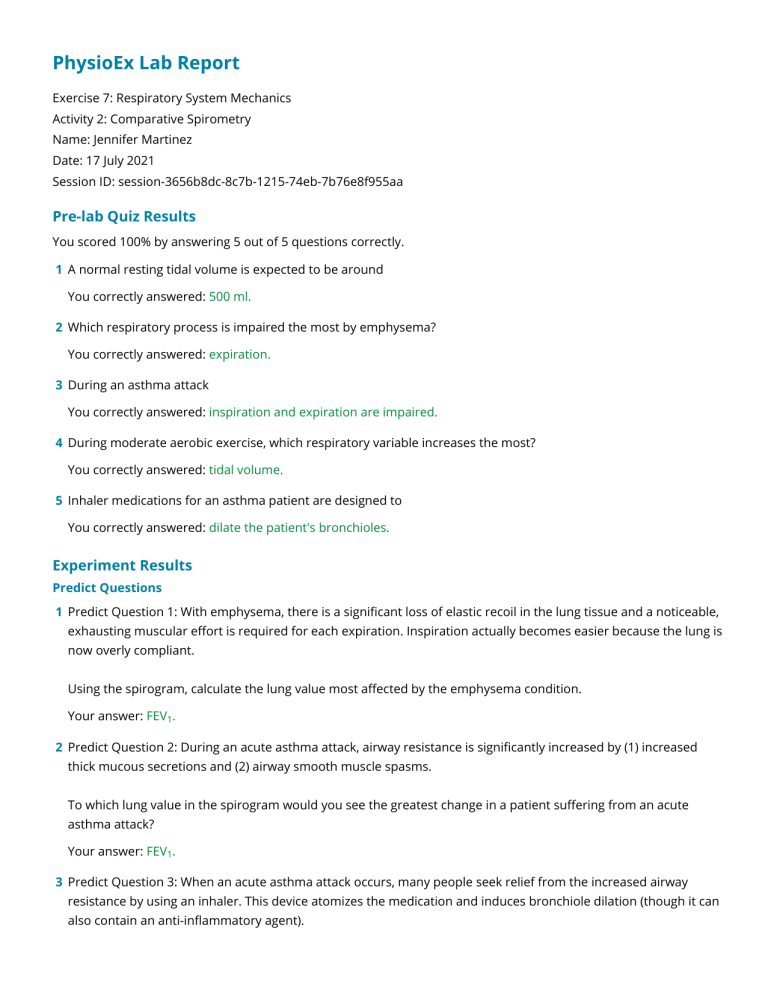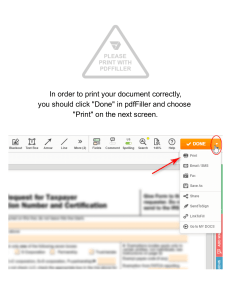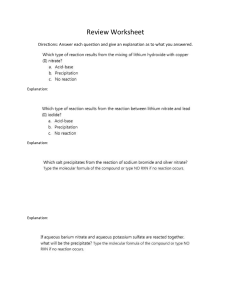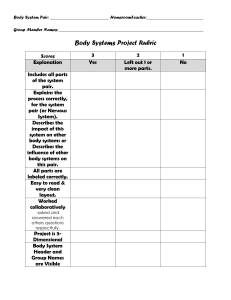
PhysioEx Lab Report Exercise 7: Respiratory System Mechanics Activity 2: Comparative Spirometry Name: Jennifer Martinez Date: 17 July 2021 Session ID: session-3656b8dc-8c7b-1215-74eb-7b76e8f955aa Pre-lab Quiz Results You scored 100% by answering 5 out of 5 questions correctly. 1 A normal resting tidal volume is expected to be around You correctly answered: 500 ml. 2 Which respiratory process is impaired the most by emphysema? You correctly answered: expiration. 3 During an asthma attack You correctly answered: inspiration and expiration are impaired. 4 During moderate aerobic exercise, which respiratory variable increases the most? You correctly answered: tidal volume. 5 Inhaler medications for an asthma patient are designed to You correctly answered: dilate the patient's bronchioles. Experiment Results Predict Questions 1 Predict Question 1: With emphysema, there is a significant loss of elastic recoil in the lung tissue and a noticeable, exhausting muscular effort is required for each expiration. Inspiration actually becomes easier because the lung is now overly compliant. Using the spirogram, calculate the lung value most affected by the emphysema condition. Your answer: FEV1. 2 Predict Question 2: During an acute asthma attack, airway resistance is significantly increased by (1) increased thick mucous secretions and (2) airway smooth muscle spasms. To which lung value in the spirogram would you see the greatest change in a patient suffering from an acute asthma attack? Your answer: FEV1. 3 Predict Question 3: When an acute asthma attack occurs, many people seek relief from the increased airway resistance by using an inhaler. This device atomizes the medication and induces bronchiole dilation (though it can also contain an anti-inflammatory agent). Which lung value remained relatively unchanged when comparing a patient with an acute asthma attack, acute asthma attack with inhaler, and normal? Your answer: RV. 4 Predict Question 4: During moderate aerobic exercise, the human body will change its respiratory cycle in order to meet increased metabolic demands. During heavy exercise, further changes in respiration are required to meet the extreme metabolic demands of the body. Which lung value will change more during moderate exercise, the ERV or the IRV? Your answer: IRV. Stop & Think Questions 1 When obstructive lung disease develops, what happens to the FEV1 (%)? You correctly answered: It decreases. 2 Compared with the normal patient, what happened to the FVC in this patient? You correctly answered: It decreased. 3 Compared with the normal patient, what happened to the FEV1 in this patient? You correctly answered: It decreased. 4 Compared with the normal patient, what happened to the FVC in this patient? You correctly answered: It decreased. 5 Compared with the normal patient, what happened to the FEV1 in this patient? You correctly answered: It decreased. 6 Which value in the spirogram never changed from that of the normal patient? You correctly answered: TLC. 7 For both types of exercise, the tidal volumes and breathing rates were increased. Compared with normal values, did tidal volume or breathing rate increase more during moderate exercise? (Determine the percentage by which each value changed.) You correctly answered: tidal volume. Experiment Data Patient Type TV ERV IRV RV FVC TLC FEV1 FEV1(%) Heavy Exercise 3650 750 600 1000 ND 6000 ND ND Moderate Exercise 1875 1125 2000 1000 ND 6000 ND ND Asthma Attack Plus Inhaler 500 1500 2800 1200 4800 6000 3840 80% Acute Asthma Attack 300 750 2700 2250 3750 6000 1500 40% Emphysema 500 750 2000 2750 3250 6000 1625 50% Normal 500 1500 3000 1000 5000 6000 4000 80% Normal Emphysema Acute Asthma Attack Asthma Attack Plus Inhaler Moderate Exercise Heavy Exercise Post-lab Quiz Results You scored 100% by answering 5 out of 5 questions correctly. 1 Which of the following respiratory values represents a decreased flow rate during the obstructive lung disease(s)? You correctly answered: FEV1. 2 Calculate the ERV of an individual with the following respiratory volumes: TLC = 6000 ml, FVC = 4800 ml, RV = 1200 ml, IRV = 2900 ml, TV = 500 ml. You correctly answered: 1400 ml. 3 Calculate the FVC of an individual with the following respiratory volumes: RV = 1000 ml, IRV = 3000 ml, TV = 500 ml, ERV = 1500 ml. You correctly answered: 5000 ml. 4 What is the largest volume for the normal patient? You correctly answered: IRV. 5 What happened to the RV for the emphysema patient and the asthmatic patient? You correctly answered: It decreased for both patients. Review Sheet Results 1 What lung values changed (from those of the normal patient) in the spirogram when the patient with emphysema was selected? Why did these values change as they did? How well did the results compare with your prediction? Your answer: ERV, IRV, RV, FVC, FEV, and FEV1 (and its percentage). These values changed because emphysema causes significant loss of elastic recoil in lung tissue. The change corresponds to my prediction. 2 Which of these two parameters changed more for the patient with emphysema, the FVC or the FEV1? Your answer: FEV 1 changed more. 3 What lung values changed (from those of the normal patient) in the spirogram when the patient experiencing an acute asthma attack was selected? Why did these values change as they did? How well did the results compare with your prediction? Your answer: TV, ERV, IRV, RV, FVC, FEV1 and FEV1 % changes. These changes are due to the bronchiole smooth muscle spasm and the airways become constricted (smaller diameter). The result corresponds to my prediction. 4 How is having an acute asthma attack similar to having emphysema? How is it different? Your answer: Both of their lung capacity remain the same as well as their exhaling. They are different that, asthma attack reduces more FEV1% than emphysema. 5 Describe the effect that the inhaler medication had on the asthmatic patient. Did all spirogram values return to "normal"? Why do you think some values did not return all the way to normal? How well did the results compare with your prediction? Your answer: The inhaler helps the patient to make some value close to normal. The IRV(slightly), TV, RV,ERV, FEV1,FEV1(%) are changed. They do not back to normal because the smooth muscle in the bronchioles cannot be recovered by using the inhaler.My prediction corresponds to the result. 6 How much of an increase in FEV1 do you think is required for it to be considered significantly improved by the medication? Your answer: 10%-15% of change will be considered significant. 7 With moderate aerobic exercise, which changed more from normal breathing, the ERV or the IRV? How well did the results compare with your prediction? Your answer: IRV changes more than ERV. My hypothesis was correct. 8 Compare the breathing rates during normal breathing, moderate exercise, and heavy exercise. Your answer: Breathing rates increase with exercise. The heavier the exercise the greater the change.



